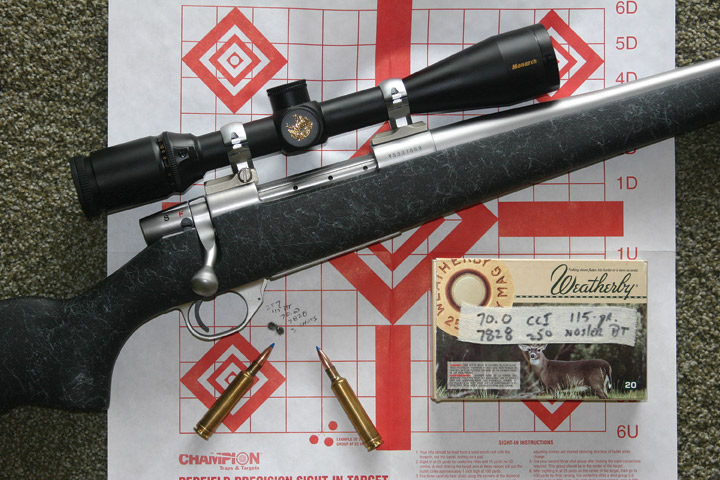At GunDigest, we independently review products. However, we may earn a commission when you purchase through links on our site. Learn More
Cartridge Review: The Hard-Hitting .257 Weatherby Magnum

By and large, I am not of the “sniper” mindset when it comes to hunting North American big game. That is to say, I believe in getting as close as possible before taking the shot.
That said, when I moved to southern Arizona several years ago I wanted a rifle that would reach across big, deep canyons and kill the diminutive, super-sneaky Coues whitetail and mountain muleys, as well as tune up flat-country pronghorn when necessary. Thus I acquired a Weatherby Vanguard MOA rifle chambered for Roy Weatherby’s all-time favorite, the .257 Weatherby Magnum.
It has proven to be a great choice.
The .257’s Pedigree
Designed in 1944—a year before Roy Weatherby went into the commercial gun business—the .257 Weatherby Magnum is a .25-caliber belted bottlenecked cartridge. It is one of the original standard length magnums developed by shortening the .375 H&H Magnum case to approx. 2.5 inches. It is one of the flattest-shooting commercial cartridges available today.
One of its most popular factory loads features the 115-grain Nosler Ballistic Tip bullet with a muzzle velocity of 3,400 fps, which generates 2,952 ft.-lbs. of kinetic energy (K.E.)—comparable muzzle energy to the .30-06 and .35 Whelen.
The .257 Weatherby Magnum shares the same cartridge case as both the .270 and 7mm Weatherby Magnums. The .30 Super Belted Rimless H&H served as the direct parent cartridge for the case design, and served as the forerunner to the standard length magnum cartridges such as the 7mm Remington Magnum and the .338 Winchester Magnum.
There has been some speculation that Roy Weatherby may have used the full length .375 H&H Magnum case if he had slow burning powders available today when the cartridge was designed. The shortening of the case allowed for the more efficient use of the slowest powder of the day, IMR 4350—a powder that would not have provided any great advantage for such cartridges as the .257 or .270 Weatherby Magnums if such cartridges utilized the full length H&H case.
Today, IMR 4350 is considered almost too fast a burning propellant for the cartridge which comes into its own with the slowest burning powders now available. These include IMR 7828, H4831, RL22, RL25, AA3100, and Viht N160 and N165, among others.
500-Yard Accuracy
Bullet weights for the .257 Weatherby range in weight from 75-120 grains, with the most popular for big game hunting weighing 100-120 grains. It is a hunting cartridge and has not been, for the most part, adapted into any target shooting discipline.
The cartridge really shines when and where shooting at game over long distances is required. It is ideal for small to medium-sized deer, pronghorn, and other small ungulates. I have also used mine when hunting predators like coyotes, bobcats, and fox, though because the barrel heats up extremely quickly it is not a good choice where high-volume shooting is taking place.
In fact, care must be taken at the range to allow the barrel to sufficiently cool between groups or you’ll find that accuracy will suffer, and barrel life will be shortened. When going to the range I always bring a jug of ice water and a towel, and use it to cool the barrel after every 5-shot group. I also clean the barrel after every 10 shots.
When I went searching for a .257 Weatherby, I chose the Weatherby Vanguard MOA rifle. With a suggested retail price of right around a grand, the rifle itself is a heck of a deal for such an accurate, high-quality factory rifle.
Mine features a pillar-bedded Fiberguard composite stock with a Monte Carlo raised cheek piece and nonslip black spider-webbing, stainless steel metalwork bead blasted to a matte finish, and Pachmayr Decelerator recoil pad; it weighs in at 7 ¾ lbs. unscoped and unloaded.
Best of all, like all MOA rifles, it is guaranteed to shoot three shots into less than one inch at 100 yards using specified Weatherby factory or premium ammunition. I added Millet scope mounts, a 4-16X Nikon Monarch riflescope and Butler Creek sling, and this rifle is just what the doctor ordered for hunting where shots just might be “way out there.” And though a big load when it goes off, recoil is almost nonexistent.
Handloads for the .257
I spent a lot of time working up loads for this rifle—while I love Weatherby factory ammo, it is a bit pricey for somebody who likes to shoot a lot—and finally settled on a load of 70 grains of IMR 7828, either the 110-grain Nosler AccuBond or 115-grain Nosler Ballistic Tip bullet, and CCI 250 primer.
Both of these loads produce consistent 3-shot groups of about ½-inch at 100 yards, and allow me to ring an 8-inch metal gong pretty much every shot out to 500 yards.
The .257 Weatherby Magnum will never be one of the country’s top 10 best-selling hunting cartridges, nor should it be. It is a specialty cartridge designed for long-range shooting at small- and medium-sized big game.
For that task, it is an excellent choice.
This article appeared in the April 8, 2013 issue of Gun Digest the Magazine.
Next Step: Get your FREE Printable Target Pack
Enhance your shooting precision with our 62 MOA Targets, perfect for rifles and handguns. Crafted in collaboration with Storm Tactical for accuracy and versatility.
Subscribe to the Gun Digest email newsletter and get your downloadable target pack sent straight to your inbox. Stay updated with the latest firearms info in the industry.